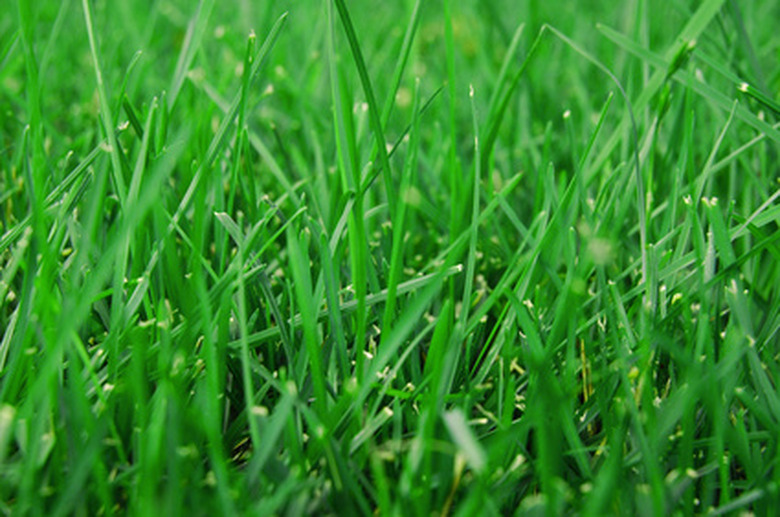Types Of Grass Blades
Turf grasses vary widely in their texture, color and appearance. Different grasses have different temperature and care requirements, but they also vary in the size and shape of the grass blades. This difference in the individual blades can make one lawn look quite different from the next.
Fine Blades
Grasses that have very fine, thin blades of grass create a soft, luxurious feel in a landscape. While beautiful, they are also the least hardy of all the grasses. Creeping bent grass (Agrostis stolonifera) has a fine texture, as do some varieties of Bermuda grass (Cynodon dactylon). In fact, the thinnest blades of grass come from three Bermuda varieties that are usually only found in upscale golf courses.
- Turf grasses vary widely in their texture, color and appearance.
- Different grasses have different temperature and care requirements, but they also vary in the size and shape of the grass blades.
Medium Blade
Grasses with medium-width blades offer the best of both worlds: They are usually somewhat hardy, do not run and also present a pleasing appearance. These grasses are commonly used in home lawns. Many of the fescues (Festuca sp.) have single, medium-width blades, including the popular red fescue. Centipede grass (Eremochloa ophiuroides) has medium-sized blades and can thrive even in poor soil, but it cannot tolerate cold temperatures.
Broad Blades
Grasses with broad blades are often called "coarse" grasses because the texture of the lawn feels coarse. These hardy, low-maintenance grasses are a good choice for ground cover in hard-to-grow areas or when an economic choice is needed. Varieties of St. Augustine grass (Stenotaphrum secundatum) are popular in the south. The blades of this grass are broad and blunt at the tip. It is also fast growing, hardy, and will quickly spread to fill bare areas. Carpetgrass (Axonopus affinis) has wide blades with round tips and grows well even in shady areas.
- Grasses with medium-width blades offer the best of both worlds: They are usually somewhat hardy, do not run and also present a pleasing appearance.
- Centipede grass (Eremochloa ophiuroides) has medium-sized blades and can thrive even in poor soil, but it cannot tolerate cold temperatures.
Types Of Grass Blades
Identifying the type of grass in your lawn helps you mow, fertilize and water correctly. Grass blades shoot forth from tubular sheaths near the crown of the plant, which emerges from the root rhizomes or stolons. When identifying a grass blade type, select several samples of mature grass blades for study. Leaf size varies from narrow and thin to large and flat, depending on the species. Leaves may emerge from the sheath slightly rolled, so flatten the leaf before examining its shape so you can better locate midribs, if they are present. Tall fescue has hook-like hairs along the leaf surface, which you can both see and feel. Some grasses have other features that make their leaf blades distinctive from other grass varieties. The dull green leaves of St. Augustine (Stenotaphrum secundatum), hardy in USDA zones 8 through 10, lay almost flat on the ground as they emerge from the central crown.
- Identifying the type of grass in your lawn helps you mow, fertilize and water correctly.
- Tall fescue has hook-like hairs along the leaf surface, which you can both see and feel.
Types Of Grass Blades
Identifying the type of grass in your lawn helps you mow, fertilize and water correctly. Grass blades shoot forth from tubular sheaths near the crown of the plant, which emerges from the root rhizomes or stolons. When identifying a grass blade type, select several samples of mature grass blades for study. Leaf size varies from narrow and thin to large and flat, depending on the species. Leaves may emerge from the sheath slightly rolled, so flatten the leaf before examining its shape so you can better locate midribs, if they are present. Tall fescue has hook-like hairs along the leaf surface, which you can both see and feel. Some grasses have other features that make their leaf blades distinctive from other grass varieties. The dull green leaves of St. Augustine (Stenotaphrum secundatum), hardy in USDA zones 8 through 10, lay almost flat on the ground as they emerge from the central crown.
- Identifying the type of grass in your lawn helps you mow, fertilize and water correctly.
- Tall fescue has hook-like hairs along the leaf surface, which you can both see and feel.
References
- GardenPlace.com: Lawn Grasses
- Forrest Seeding Service: Grass Type Chart
- Arizona Cooperative Extension: Lawns: Growth Characteristics of Turf Grasses
- Purdue University Extension: How to Identify a Turfgrass
- Arizona Cooperative Extension: Cold Season Grasses
- Arizona Cooperative Extension: Lawns: Growth Characteristics of Turf Grasses
- Purdue University Extension: How to Identify a Turfgrass
- Arizona Cooperative Extension: Cold Season Grasses
